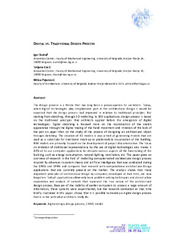Приказ основних података о документу
Digital vs. Traditional Design Process
| dc.contributor | Krstić-Furundžić, Aleksandra | |
| dc.contributor | Vukmirović, Milena | |
| dc.contributor | Vaništa Lazarević, Eva | |
| dc.contributor | Đukić, Aleksandra | |
| dc.creator | Svetel, Igor | |
| dc.creator | Kosić, Tatjana | |
| dc.creator | Pejanović, Milica | |
| dc.date.accessioned | 2023-03-08T20:38:05Z | |
| dc.date.available | 2023-03-08T20:38:05Z | |
| dc.date.issued | 2018 | |
| dc.identifier.isbn | 978-86-7924-199-3 | |
| dc.identifier.uri | https://machinery.mas.bg.ac.rs/handle/123456789/5534 | |
| dc.description.abstract | The design process is a theme that has long been a preoccupation for architects. Today, when digital technologies play irreplaceable part in the architectural design it would be expected that the design process had improved in relation to traditional principles. But starting from sketching, through 3D modelling, to BIM applications, design process is based on the traditional principles that architects applied before the emergence of digital technologies. Digital sketching is focused more on the reproduction of the sketch appearance through the digital tracing of the hand movement and imitation of the look of the pen on paper than on the study of the process of designing an architectural object through sketching. The creation of 3D models is also aimed at generating models that are used as a substitute for traditional mock-up or photorealistic visualization of the building. BIM models are primarily focused on the development of project documentation. The focus on imitation of traditional representations by the use of digital technologies also makes it difficult to use computer applications to simulate various aspects of the functioning of the building, such as energy consumption, natural lighting, ventilation, etc. The paper gives an overview of research in the field of modelling computer-aided architectural design process inspired by advances in system theory and artificial intelligence that was conducted during the 1980s and 1990s and compares that research with computational architectural design applications that are currently present on the market. The analysis shows that many important principles of architectural design by computer, developed at that time, are now forgotten. Today's applications allow only basic problem solving techniques and do not allow exploration and analysis of variants that represent the true nature of the architectural design process. Because of the inability of earlier computers to process a large amount of information, these systems were experimental, but the research conducted at that time briefly illustrated in this paper, shows that it is possible to develop a digital design process that is in line with what architects really do. | sr |
| dc.language.iso | en | sr |
| dc.publisher | Belgrade: Faculty of Architecture | sr |
| dc.relation | info:eu-repo/grantAgreement/MESTD/Technological Development (TD or TR)/36038/RS// | sr |
| dc.rights | openAccess | sr |
| dc.source | Proceedings of 5th International Academic Conference on Places and Technologies, “Places and Technologies 2018 – Keeping up with technologies to adapt cities for future challenges” | sr |
| dc.subject | digital design | sr |
| dc.subject | design process | sr |
| dc.subject | CAAD | sr |
| dc.subject | model | sr |
| dc.title | Digital vs. Traditional Design Process | sr |
| dc.type | conferenceObject | sr |
| dc.rights.license | ARR | sr |
| dc.citation.epage | 460 | |
| dc.citation.spage | 453 | |
| dc.identifier.fulltext | http://machinery.mas.bg.ac.rs/bitstream/id/13571/bitstream_13571.pdf | |
| dc.identifier.rcub | https://hdl.handle.net/21.15107/rcub_machinery_5534 | |
| dc.type.version | acceptedVersion | sr |


